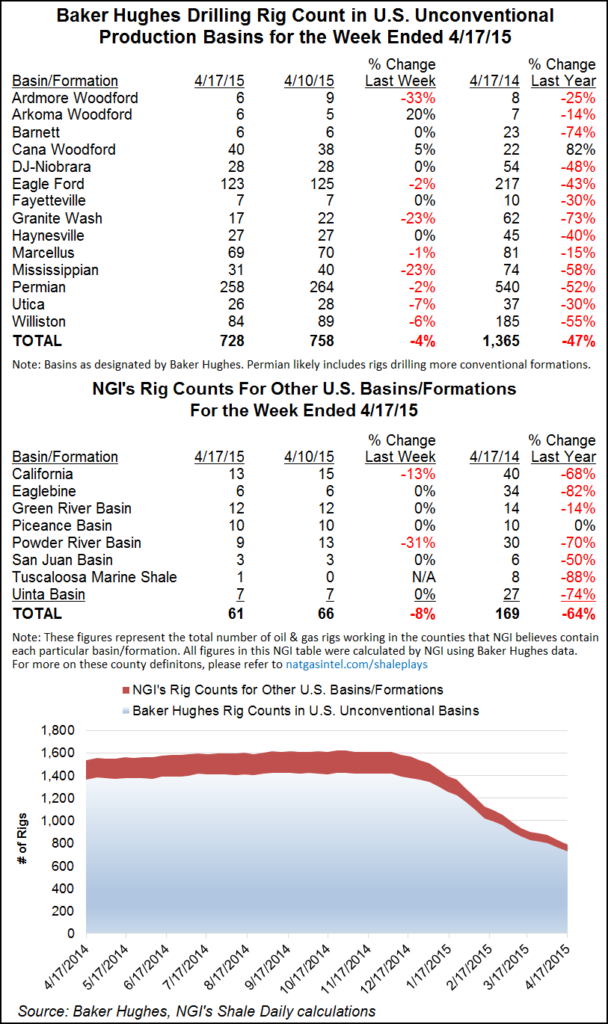Shale Daily | E&P | NGI All News Access
U.S. Onshore Activity Flattens, with Six Rigs Dropped, Says BHGE
Domestic oil and natural gas producers dropped six land rigs as of Wednesday (Nov. 21) from a week earlier, but gains in Canada and the Gulf of Mexico lifted the overall North American count by four, according to data compiled by Baker Hughes, a GE Company (BHGE).

The U.S. land rig count ended the shortened holiday week at 1,052, versus 1,058 a week earlier but 152 rigs more than in the year-ago period. In the Gulf of Mexico, drilling activity strengthened, with 25 rigs in operation, up three from the preceding week and three more than a year ago.
Overall, U.S. producers were running a total of 1,079 rigs as of Wednesday, which was down three week/week but 156 higher than a year earlier. Canada added seven rigs for the week to end at 204, compared with 215 a year ago.
The North American overall rig count ticked four higher to end at 1,283, compared with the year-ago count of 1,138.
Digging deeper into the U.S. data, the natural gas rig count was static week/week at 194 but up 18 from a year ago, while three oil rigs were dropped to end at 885 from the year-ago tally of 747.
U.S. producers were running 73 directional rigs as of Wednesday, up two week/week and two higher than in the year-ago period. Meanwhile, 10 horizontal rigs were dropped to end at 929, still much higher than the 786 running a year earlier. U.S. operators also added five vertical rigs to hit 77, compared with 66 a year ago.
Canada producers added six oil rigs for the week to end at 124, versus 107 a year ago, and they added one gas rig to hit 80 compared with 108 in the same period of 2017.
Louisiana was the big winner among the states for the week, adding four rigs from the preceding week to 69. New Mexico, boosted by the Permian Basin, added three rigs week/week to end at 108.
States dropping rigs from a week earlier were led by North Dakota, down three to 52, and Texas, also down three to end at 532. Oklahoma dropped two rigs from a week earlier to end at 144, joining Wyoming, which also dropped two to end at 28.
Alaska was down one rig week/week to five, and Utah lost one rig and ended at four.
The rig count was static from a week earlier in California (15), Colorado (34), Ohio (16), Pennsylvania (46) and West Virginia (13).
Interestingly, nearly every single major oil and gas play in the Lower 48 showed a flat rig count from a week earlier, led by the Permian Basin (493), Marcellus Shale (58), Haynesville Shale (51), Denver-Julesburg/Niobrara formation (29), Utica Shale (17), Arkoma Woodford (7), Ardmore Woodford (3) and Barnett Shale (1).
Those basins dropping rigs from a week earlier were the Cana Woodford, down three to end Wednesday at 78, while the Eagle Ford Shale was down one to 78. The Williston Basin also dropped one rig to 56, and the Granite Wash lost one to end at 15.
Although the Williston was down one rig for the week, North Dakota production is telling a different tale, according to the most recent statistics from the Department of Mineral Resources (DMR). Oil production in September rose about 5%, by 66,000 b/d, while natural gas production was up about 3.6% or 89 MMcf/d.
“This is the first time in about three years that oil has increased more rapidly than gas,” DMR Director Lynn Helms said. “We’re starting to see oil and gas production synchronize more.”
September oil production was 40.7 million bbl (1.36 million b/d) versus 40 million bbl (1.29 million b/d) in August, setting an all-time high. Gas production also set a new record at 75.9 Bcf (2.53 Bcf/d) in September, compared to 75.7 Bcf (2.44 Bcf/d) in August.
© 2024 Natural Gas Intelligence. All rights reserved.
ISSN © 2577-9877 | ISSN © 2158-8023 |
